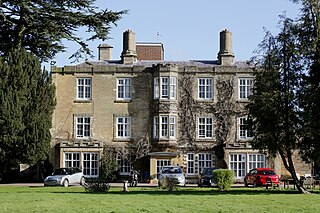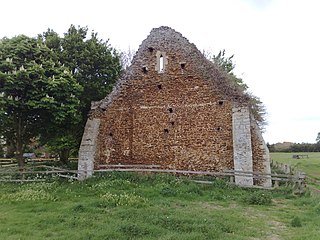
An abbey is a complex of buildings, a type of monastery used by members of a religious order under the governance of an abbot or abbess. It provides a place for religious activities, work, and housing of Christian monks and nuns.

Wymondham Abbey is the Anglican parish church for the town of Wymondham in Norfolk, England.

Alvecote Priory is a ruined Benedictine Priory in Alvecote, Warwickshire, England. The site has been scheduled as an ancient monument. Now very little remains of the priory, most of the walls have been eroded but a fairly high wall remains on one side. The main entrance arch is the most impressive feature, still standing at around 20 feet (6.1 m) high. The attached dovecote also survives, however both the ruined priory and dovecot are on the Heritage at Risk Register due to vandalism and water damage.

Cluny Abbey is a former Benedictine monastery in Cluny, Saône-et-Loire, France. It was dedicated to St Peter.

Pluscarden Abbey is a Roman Catholic Benedictine monastery in the glen of the Black Burn, 6 miles south-west of Elgin, Moray, Scotland. It was founded in 1230 by Alexander II for the Valliscaulian Order.

Thetford Priory is a Cluniac monastic house in Thetford, Norfolk, England.

Isleham Priory Church located in Isleham, Cambridgeshire is a Norman church, built in ca 1090. Despite being converted into a barn, it remains in a largely unaltered state.

Snelshall Priory was a Benedictine priory in Milton Keynes, Buckinghamshire in the United Kingdom, built around 1200. The priory was founded after Sybil d'Aungerville granted land at Tattenhoe to Lavendon Abbey, a Premonstratensian monastery of 'White canons' who most likely started a cell at Snelshall. This did not thrive and was abandoned about 1207. About 1219, the founder's son brought in Benedictine monks, increased the endowment and the new monastery began again. However Snelshall Priory paid 1 mark a year to Lavendon until 1232, at which point the Bishop of Lincoln decided that Snelshall owned its own lands and chapel. The priory accumulated various land through gifts, but even with all these grants, in 1321 when Henry Burghersh visited, it was so poor that "the monks scarcely had the necessities of life and had to beg even for these".

Canterbury College, Oxford (1311-1540), was a University of Oxford college owned and run by Christ Church Priory, Canterbury. Shortly after the dissolution of the monasteries, the college's hall, chapel and other buildings were surrendered on 10 April 1540 and acquired by Christ Church.

Hatfield Broad Oak Priory, or Hatfield Regis Priory, is a former Benedictine priory in Hatfield Broad Oak, Essex, England. Founded by 1139, it was dissolved in 1536 as part of Henry VIII's dissolution of the monasteries.

Outwell is a village and civil parish in the borough of King's Lynn and West Norfolk, in the English county of Norfolk.

Tickford Priory was a medieval monastic house in Newport Pagnell in Buckinghamshire, England.
Horton Priory was a priory at Horton in Dorset, England.

Belvoir Priory was a Benedictine priory near to Belvoir Castle. Although once described as within Lincolnshire, it is currently located in Leicestershire, near the present Belvoir Lodge.
Freiston Priory was a Benedictine cell of Crowland Abbey founded in 1114, and became a priory soon afterwards. It was Dissolved in 1539 and was located in Freiston, Lincolnshire, England.

St. Mary Magdalen was a Benedictine priory in Lincoln, England. Along with Sandtoft Priory and Hanes Cell, it was a Lincolnshire cell of St Mary's Abbey in York, England. A surviving building, once owned by the priory, is Monks' Abbey, Lincoln.

St Leonard's Priory, Stamford was a priory in Lincolnshire, England. It was built in Stamford, supposedly on the site of a monastery which was founded by St Wilfrid in 658 and destroyed in the Danish invasion.

Blackborough Priory was a Benedictine monastic house in Norfolk, England, about 5 miles or 8 km south east of King's Lynn. The Ordnance Survey map shows the remains of fishponds nearby, which may have been for the use of the monastery.
Rumburgh Priory was a Benedictine priory in located in the village of Rumburgh in the English county of Suffolk. The priory was founded in about 1065 as a cell of St Benet's Abbey at Hulme in Norfolk. At the time of the Domesday survey it had 12 monks. The ownership of the priory was transferred to St Mary's Abbey in York towards the end of the 12th century. The priory had chapels at Wissett and Spexhall but was "suppressed" in 1528 by Cardinal Wolsey and used to provide funds for the building of Cardinal College in Ipswich.
















